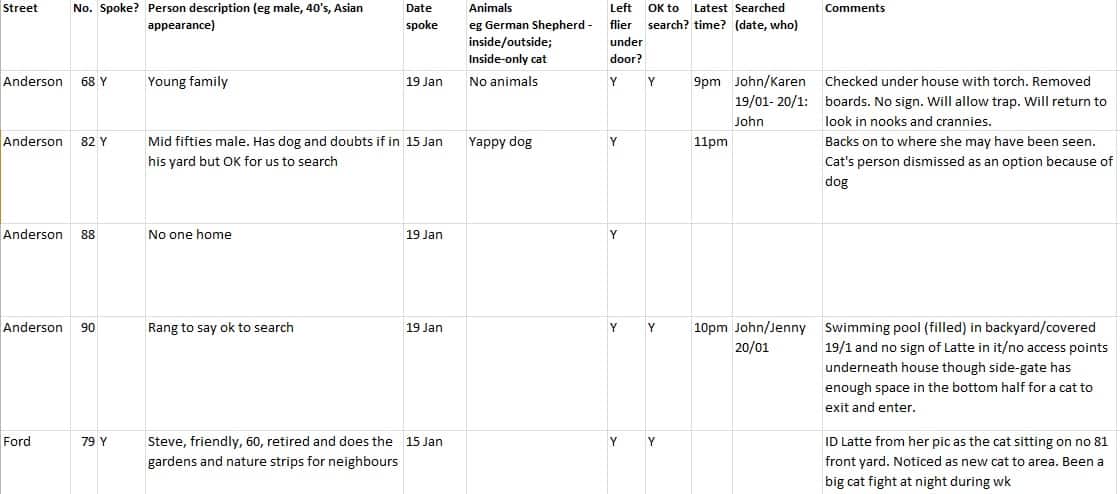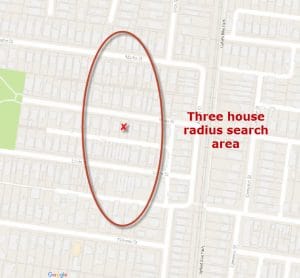
If you’ve searched your own property and didn’t find them, it’s time to start searching further afield. To do this, you need to first identify the highest priority houses to search, then prepare the information you’ll need to give your neighbours.
1. Identify your priority areas
Cats don’t walk along footpaths like we do – they jump over, and under fences; they walk along rooves. So you need to think like a cat and map out your priority search areas, starting with the properties that are closest, then working your way out.
Make sure you include properties at the back of your place and on different streets.
-
- First priority: a three-house radius from your home.
- Second priority: a five-house radius.
2. Prepare information for neighbours
Next, prepare what you’ll need so you can approach neighbours and ask permission to search their properties. The more prepared you are, the better a response you’ll receive.
Prepare flier
If you have a lost flier to give people, they’re less likely to think you’re a crackpot or a thief casing their property. Include a good photo of your kitty and basic details. ‘Reward’ as the first word gets people’s attention.
If your foster kitty is with a rescue group, include their logo.
To reduce printing costs, we design with two A5 fliers per A4 page. You won’t be putting these fliers on lamp posts, so they don’t need to be huge – just enough for people to see what your cat looks like and the basic info.
Download sample flier – Portrait photo. Download sample flier – Landscape photo.
Prepare letter
Some people may initially be taken aback when you ask if you can search their property. If you explain that timid cats hide, and have reputable research to show them, they may be more open to it.
So write and print the letter which explains why you need to search their property.
Prepare record sheet
Prepare a sheet to record details of your cat search work. This is really important if multiple people are searching – some neighbours may get cranky if they’re approached by multiple people. We use Excel (if we’re the only ones searching) or Googlesheets (if multiple people are involved).

Keep a detailed record of who you’ve doorknocked and spoken to, and which properties you’ve searched. We use Excel or Googlesheets.
Download our record sheet – template (.xls). It includes:
- basic information about the cat
- doorknocking records – who you spoke to, when, animals who live there, if they’re happy to have a wildlife camera or for you to search, if you left a flier under their front door if they weren’t home etc
- observations from wildlife cameras – date, location, animals who appeared on camera etc
- locations of your big signs
- locations of your ‘walking, talking and sitting’
- contact details of other people you’ve spoken to (eg dog walkers) or who have contacted you in response to big signs
- sightings
- maps of sightings.
Prepare spiel
Prepare what you’re going to say to neighbours. Download our spiel if you’re stuck.
(Optional) Make up ID badges
If you’re a rescue group volunteer, ask permission to make up identity badges and wear these and a rescue group top when door knocking. Take some rescue group fliers with you – this helps people realise you’re legit.
(Optional) Prepare thank you notes
You really need neighbours’ help to find your missing cat. Maintaining goodwill, and letting people know how you went, is helpful.
We like to leave ‘thank you notes‘ under their door after we’ve searched.
3. Get support
Ask your friends, family, fellow rescue volunteers, neighbours, colleagues – anyone you can – if they’ll help you door knock and search. Moral support at this stressful time is very helpful. We’ve found people are also more comfortable if there are two people door knocking, rather than one.
Ready for next step?
Now that you have everything you need, it’s time to start doorknocking your neighbours and asking to set up wildlife cameras or search their properties after dark.
